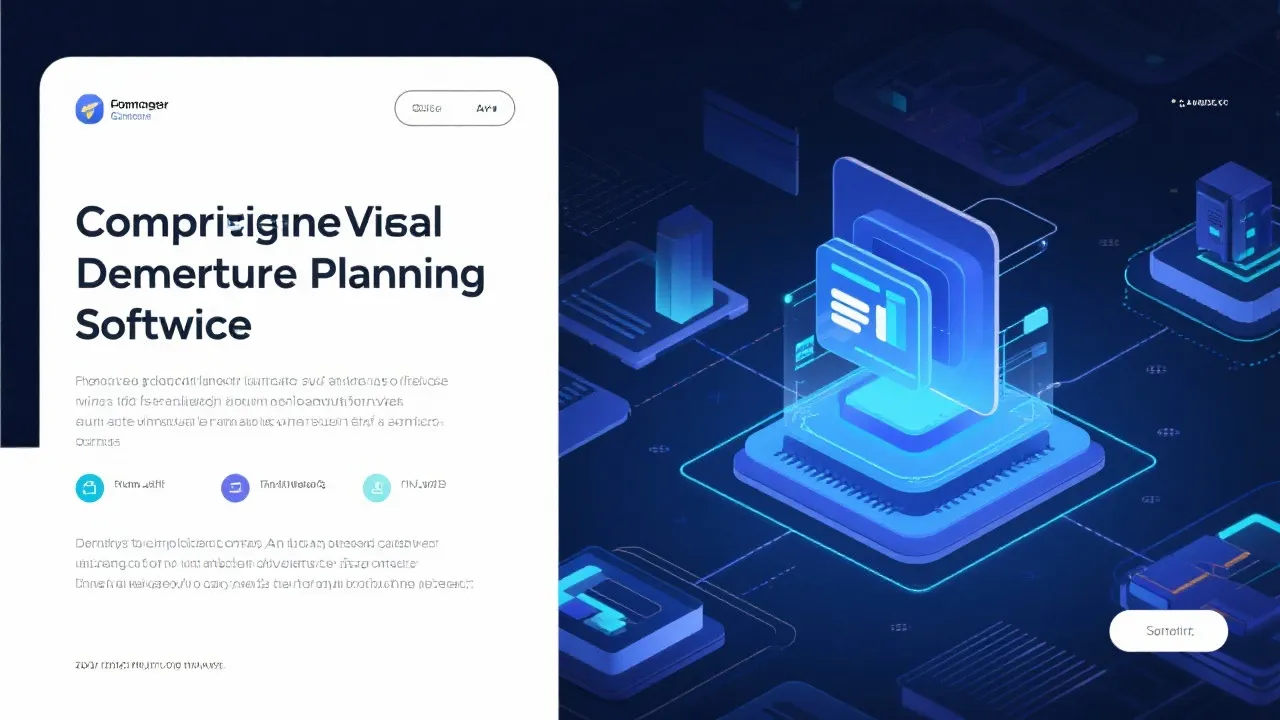A Comprehensive Guide to Demand Planning Software
Demand planning software is a key asset for businesses aiming to accurately forecast demand, optimize inventory, and enhance supply chain efficiency. Leveraging historical data and AI insights, these tools allow companies to align production with customer needs, minimize waste, and boost customer satisfaction, establishing a competitive edge in dynamic markets.

Introduction to Demand Planning Software
Demand planning tools empower businesses by enabling them to predict future customer needs, keep stock optimized, and streamline supply chain operations. By making use of past data, trends, and AI-driven forecasts, these solutions help manage stock levels effectively, preventing both excess inventory and stock shortages. Demand planning software not only enhances forecasting but also provides businesses with actionable insights derived from historical sales, market behavior, and consumer patterns, which allows companies to respond proactively to market demands.
How Businesses Benefit
Utilizing demand planning technology assists companies in making informed decisions that align stock and production with real consumer demand. This alignment minimizes waste, cuts costs of carrying unwanted inventory, and improves customer satisfaction by ensuring product availability. In our rapidly changing market landscape, employing these tools is vital for maintaining competitiveness and adaptability. The ability to accurately forecast demands translates to lower operational costs, better cash flow management, and increased customer loyalty through improved service levels. Organizations that leverage demand planning tools effectively can also adapt quickly to market changes, altering production schedules and inventory levels to avoid potential pitfalls, such as unsold stock or customer disappointment caused by product shortages.
Key Features of Demand Planning Tools
1️⃣ Forecasting Demand
✔️ Leveraging AI and machine learning for prediction accuracy. With advancements in technology, demand planning tools now utilize sophisticated algorithms to analyze data patterns and provide reliable forecasts.
✔️ Evaluating historical sales, trends, and seasonal factors. Comprehensive analysis of past performance helps predict future demands with greater precision, ensuring that businesses are adequately prepared for shifts in consumer behavior.
2️⃣ Optimizing Inventory
✔️ Minimizes overstocking and prevents shortages. By accurately forecasting demand, businesses can reduce instances of excess stock, which ties up capital and incurs storage costs.
✔️ Balances stock levels efficiently to meet consumer demand. Optimized inventory management not only satisfies customer demand but also streamlines warehouse processes, reducing handling costs and enhancing overall efficiency.
3️⃣ Data and Analytics in Real-Time
✔️ Monitors market movements, supplier input, and demand. Real-time analytics offer invaluable insights, enabling businesses to react quickly to external factors such as economic shifts or competitor actions.
✔️ Offers fastaneous insights for strategic decision-making. The rapid identification of trends allows businesses to pivot strategies to capitalize on emerging opportunities or avoid potential losses.
4️⃣ Supply Chain Synergy
✔️ Integrates with ERP and warehouse systems. Demand planning software is most effective when it complements existing enterprise resource planning (ERP) systems, ensuring a seamless flow of information across departments.
✔️ Fosters better cooperation between suppliers and producers. Enhanced communication and data sharing with suppliers lead to more synchronized operations, improving the overall supply chain performance.
5️⃣ Planning Scenarios and Managing Risks
✔️ Models various demand scenarios. Scenario analysis empowers businesses to prepare for different market conditions, whether they be bullish or bearish, allowing for greater resilience.
✔️ Prepares businesses for potential supply chain hiccups. Proactive risk management strategies, facilitated by demand planning software, help mitigate disruptions and enhance supply chain robustness.
Advantages of Utilizing Demand Planning Software
✔️ Enhanced Forecast Precision – Diminishes demand uncertainties, allowing businesses to operate with increased confidence about future sales trends.
✔️ Cost Efficiency – Curtails unnecessary stock-holding expenses, freeing up capital for other ventures or investments.
✔️ Stronger Supplier and Customer Relations – Ensures timely deliveries, leading to improved supplier reliability and greater customer satisfaction.
✔️ Increased Profit Margins – Manages stock to decrease losses, resulting in a healthier bottom line.
✔️ Improved Strategic Decisions – Drives growth with data insights, allowing for more informed planning and resource allocations.
✔️ Competitive Advantage – Companies utilizing demand planning software often find themselves ahead of the curve, capable of addressing consumer needs more effectively than competitors who lack such tools. Enhanced adaptability to market dynamics fosters innovation and strategic growth.
✔️ Continuous Improvement – With ongoing access to analytical data, businesses can refine their demand planning processes continuously. Assessing performance metrics allows for iterative improvements, ensuring the systems remain aligned with both organizational goals and market fluctuations.
Implementing Demand Planning Technology
1️⃣ Understanding Business Requirements
✔️ Pinpoint demand-related challenges and goals. Identify specific problems that need addressing, such as recurring stockouts or overstocking issues, to tailor the demand planning approach effectively.
✔️ Evaluate present forecasting practices. Understanding how current methodologies perform will inform decisions about the necessary enhancements that demand planning software can provide.
2️⃣ Selecting Suitable Software
✔️ Weigh cloud-based against on-site options. The choice between on-premise and cloud solutions hinges on factors like IT infrastructure, cost, and necessary flexibility.
✔️ Check compatibility with current ERP and inventory systems. Ensuring new software integrates smoothly with existing systems is critical to achieving a unified operational framework.
3️⃣ Data Gathering and Integration
✔️ Collect past sales, market, and supply chain data. The success of demand planning tools relies heavily on access to quality historical data to generate accurate forecasts.
✔️ Integrate external data sources for enriched insights. External factors, such as economic indicators or market trends, should be considered to create a holistic view of demand forecasting.
4️⃣ Implementing AI and Machine Learning
✔️ Train models using historic demand trends. By continuously feeding data into forecasting models, the accuracy of predictions improves over time, enabling businesses to stay ahead of the curve.
✔️ Employ predictive analytics for ongoing forecasting. Regularly update models to reflect changing conditions, ensuring forecasts remain relevant and actionable.
5️⃣ User Instruction and Integration
✔️ Educate staff on system use. Proper training is essential to ensure all team members are proficient in utilizing the demand planning software to its fullest potential.
✔️ Promote seamless integration across departments. Encourage collaboration between departments such as sales, marketing, and supply chain management to foster a cohesive approach to demand planning.
6️⃣ Continuous Monitoring and Refinement
✔️ Regularly assess prediction accuracy and system performance. Establishing benchmarks will help gauge forecasting reliability and the overall effectiveness of the software.
✔️ Adjust models in response to market evolution. Stay agile by modifying forecasting models according to changes in consumer behavior, market conditions, or internal business strategies.
✔️ Incorporate Feedback Mechanisms – Once implemented, gather feedback from users to identify pain points or areas for improvement in the system, making it a more user-friendly and effective tool in the process.
✔️ Leverage Analytics for Decision Making – Use the insights gained from demand planning to guide strategic business decisions, from marketing campaigns to pricing strategies, harnessing data to drive growth.
Top Demand Planning Solutions for Companies
1️⃣ SAP Integrated Business Planning
✔️ AI-supported demand predictions and inventory control, enabling comprehensive forecasting and planning methodologies.
✔️ Suitable for major organizations with complex supply chains, facilitating cross-departmental collaboration effectively.
2️⃣ Oracle Demantra
✔️ Fast demand forecasts utilizing machine learning, granting rapid insight into market conditions.
✔️ Ideal for production and retail sectors, where anticipating consumer needs swiftly is critical to maintaining market position.
3️⃣ Kinaxis RapidResponse
✔️ Cloud-hosted solution for responsive supply chain oversight, allowing flexibility and real-time updates.
✔️ Excels in scenario analysis, helping businesses prepare and respond to various market conditions by modeling potential disruptions or opportunities.
4️⃣ Netstock
✔️ AI-powered planning for smaller and medium enterprises, offering scalable solutions for businesses with diverse inventory management needs.
✔️ Facilitates smooth ERP connectivity, ensuring alignment with existing business processes and enhancing operational efficiency.
5️⃣ ToolsGroup Service Optimizer
✔️ Advanced analytics for supply chain strategy, providing deep insights into inventory management and demand forecasting.
✔️ Focused on retail, production, and distribution sectors, tackling unique industry challenges and escalation of customer service levels.
6️⃣ Microsoft Dynamics 365 Supply Chain Management
✔️ Comprehensive solution that integrates sales, manufacturing, and distribution for unified supply chain planning.
✔️ Offers powerful analytics and AI-driven insights to support decision-making, enabling businesses to optimize their entire supply chain operations.
7️⃣ Blue Yonder Demand Planning
✔️ Focused on utilizing AI to elevate forecast accuracy and offer real-time visibility into supply chain operations.
✔️ Suitable for large scale operations seeking advanced analytic capabilities, facilitating proactive decision-making based on predictive data trends.
8️⃣ Inform Demand Planning
✔️ Real-time demand planning software that balances the complexities of changing market conditions with ease.
✔️ Comprehensive features tailored to various industries, ensuring that specific needs are addressed effectively.
9️⃣ Llamasoft Supply Chain Guru
✔️ A versatile tool for managing end-to-end supply chains with robust analytics capabilities.
✔️ Ideal for businesses looking to optimize logistics, inventory, and overall operational efficiency through data-driven insights.
🔟 Demand Works Smoothie
✔️ Provides innovative demand planning technology with user-friendly features designed for real-time collaboration and efficiency.
✔️ Suitable for companies of all sizes focusing on simplifying their forecasting processes while improving accuracy and responsiveness.
Conclusion
Demand planning software is a pivotal tool for optimizing stock levels, slashing costs, and boosting supply chain efficiency. It is key for businesses seeking to navigate an ever-evolving market landscape effectively. By selecting the appropriate software tailored to specific business needs, organizations can revolutionize their operations, enhance profitability, and create a solid foundation for future growth. The right demand planning solutions not only optimize inventory and minimize expenses, but also foster collaborative environments that enrich supplier and customer relations. Investing in demand planning technology is an essential step towards achieving operational excellence and securing a competitive edge in today's dynamic business ecosystem.
Moreover, as consumer preferences shift and global markets fluctuate, having a refined demand planning strategy will equip businesses with the necessary tools to not only survive but thrive in competitive environments. As technology continues to advance, organizations must remain agile and embrace innovative solutions that address the complexities of consumer demands and supply chain logistics. Demand planning software stands at the forefront of this evolution, fundamentally transforming the way businesses approach inventory management, forecasting, and overall operational strategy.
In essence, demand planning software is not merely a tool for operational efficiency; it is a comprehensive solution that aligns an organization’s objectives with real market conditions. Through diligent implementation, ongoing learning, and proactive adaptation, organizations can harness the power of demand planning systems to secure their market positions and enable sustainable growth well into the future.




